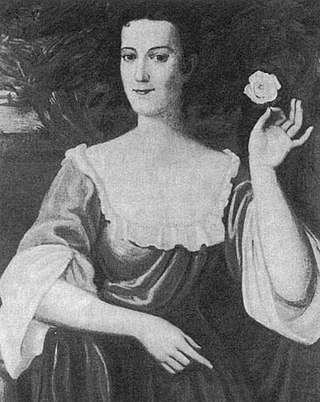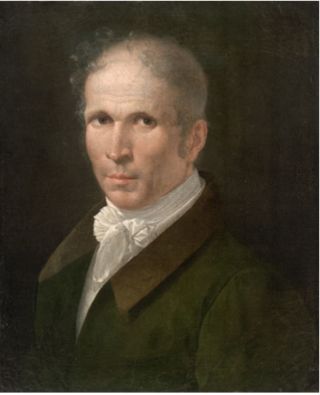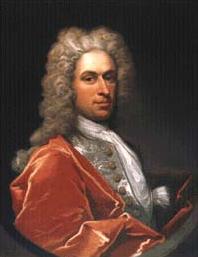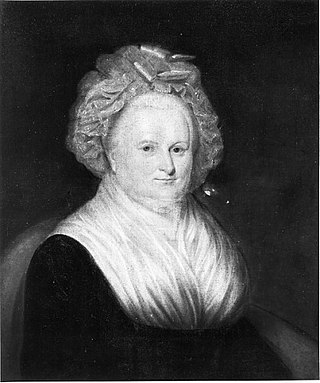
Wilson Cary Nicholas was an American politician who served in the U.S. Senate from 1799 to 1804 and was the 19th Governor of Virginia from 1814 to 1816.

Isham Randolph was an American planter, merchant, public official, and shipmaster. He was the maternal grandfather of United States President Thomas Jefferson.

First Families of Virginia were families in the British colony of Virginia who were socially prominent and wealthy, but not necessarily the earliest settlers. They descend from European colonists who primarily settled at Jamestown, Williamsburg, the Northern Neck and along the James River and other navigable waters in Virginia during the 17th century. These elite families generally married within their social class for many generations and, as a result, most surnames of First Families date to the colonial period.

Colonel Robert Carter I was a planter, merchant, and government official and administrator who served as Acting Governor of Virginia, Speaker of the Virginia House of Burgesses, and President of the Virginia Governor's Council. An agent for the Northern Neck Proprietary, Carter emerged as the wealthiest Virginia colonist and received the sobriquet "King" from his contemporaries connoting his autocratic approach and political influence.
Richneck Plantation was a property in colonial Virginia, located on the Virginia Peninsula on the northern shore of the James River between Hampton Roads and Jamestown. The Richneck manor house's foundation was discovered during construction of the George J. McIntosh elementary school, and became an archeological dig, then listed on the National Register of Historic Places.

Sarah "Sally" Cary Fairfax was the wife of George William Fairfax (1724–1787), a prominent member of the landed gentry of late Colonial Virginia and the mistress of the Virginia plantation and estate of Belvoir. She is well-remembered for being the woman with whom George Washington was apparently in love before his marriage to Martha Dandridge Custis.

Ferdinando Fairfax was a Virginia landowner and member of the prominent Fairfax family.

Colonel Thomas Lee was a planter and politician in colonial Virginia, and a member of the Lee family, a political dynasty. Lee became involved in politics in 1710, serving in both houses of the Virginia General Assembly, and also held important positions as Naval Officer for the Northern Potomac Region and agent for the Northern Neck Proprietary. After his father died, Lee inherited thousands of acres of land as well as enslaved people in then-vast Northumberland and Stafford Counties in Virginia as well as across the Potomac River in Charles County, Maryland. These properties were developed as tobacco plantations. Northumberland County was later subdivided, so some of Lee's properties were in present-day Fairfax, Fauquier, Prince William, and Loudoun counties and counties in the present-day Northern Neck of Virginia.

The Randolph family of Virginia is a prominent political family, whose members contributed to the politics of Colonial Virginia and Virginia after statehood. They are descended from the Randolphs of Morton Morrell, Warwickshire, England. The first Randolph in America was Edward Fitz Randolph, who settled in Massachusetts in 1630. His nephew, William Randolph, later came to Virginia as an orphan in 1669. He made his home at Turkey Island along the James River. Because of their numerous progeny, William Randolph and his wife, Mary Isham Randolph, have been referred to as "the Adam and Eve of Virginia". The Randolph family was the wealthiest and most powerful family in 18th-century Virginia.
George William Fairfax was a planter in colonial Virginia who represented then-vast Frederick County and later Fairfax County in the House of Burgesses before the American Revolutionary War, by which time he had returned to England. A mentor and good friend of George Washington, Fairfax made opportunities for the younger Washington through his powerful British family, and Washington assisted him afterward by arranging for the sale of his Virginia property after he returned to Britain.
Frances Jones Dandridge was the mother of Martha Washington, the first First Lady of the United States. She was born in New Kent County, Virginia. Her father Orlando Jones and maternal grandfather Colonel Gideon Macon served on the House of Burgesses in Colonial Virginia. Her parents were prosperous Virginian landowners.

Vaucluse was a villa in Fairfax County, Virginia. Located three miles (5 km) from Alexandria and 10 miles (16 km) from Washington, D.C., on a hill near the Virginia Theological Seminary. It was owned first by Dr. James Craik, and later by the Fairfax family, the first being Thomas Fairfax, 9th Lord Fairfax of Cameron.
Virginia Randolph Cary was an American writer. She was the author of Letters on Female Character, Addressed to a Young Lady, on the Death of Her Mother (1828), an influential advice book.

William Fairfax (1691–1757) was a political appointee of the British Crown in several colonies as well as a planter and politician in the Colony of Virginia. Fairfax served as Collector of Customs in Barbados, Chief Justice and governor of the Bahamas; and Customs agent in Marblehead, Massachusetts, before being reassigned to the Colony of Virginia.

Thomas Fairfax, 9th Lord Fairfax of Cameron (1762–1846), was an American planter who also held a Scottish peerage. Along with his father, on 11 December 1799, he was among the last guests at Mount Vernon before George Washington died.
John Blair was a merchant and politician of the colony of Virginia. He served in both houses of the Virginia General Assembly. As a member of the House of Burgesses, he initially represented Jamestown then Williamsburg, before being appointed to the Governor's Council. There he served for more than 25 years, including four times becoming acting governor during changes of the royal governors and while governor Francis Fauquier was in the New York and Georgia colonies. Nonetheless, this John Blair, the earliest of the four men of the name serving in the Virginia General Assembly, may be best known either as the nephew and heir of Rev. James Blair or father of John Blair, Jr..

Mary Cary Ambler was an early American diarist. Her 1770 diary provides an early account of smallpox inoculation in colonial America.
Ludwell Lee was an American lawyer and planter who served in both houses of the Virginia General Assembly representing Prince William and Fairfax Counties and rose to become the Speaker of the Virginia Senate. Beginning in 1799, following the death of his first wife, Lee built Belmont Manor, a planation house in Loudoun County, Virginia, which today is on the National Register of Historic Places.
Wilson-Miles Cary was a Virginia planter and politician who became a prominent patriot in the American Revolutionary War and later a prominent Federalist and citizen in Williamsburg. Once one of the colony's wealthiest men, Cary served in the House of Burgesses and later the Virginia House of Delegates representing at various times Warwick County, Elizabeth City County and newly created Fluvanna County. Cary also built Carysbrook plantation in Fluvanna County, where he died in the household of his grandson Wilson Jefferson Cary.











